This article was co-authored by Alphonso White and by wikiHow staff writer, Danielle Blinka, MA, MPA. Alphonso White is a Certified Personal Trainer and Fitness Coach at CompleteBody in New York City. With over 20 years of experience in the personal fitness industry, Alphonso specializes in fat loss, toning, and functional training. As an ACE Certified Personal Trainer (ACE-CPT), he creates structured, personal workout plans geared towards short and long-term fitness goals. Alphonso also holds a BS in Nutrition and Exercise Science from Queens College and is a Black Belt in Seido Karate.
This article has been viewed 48,233 times.
If you're looking for new exercises to work your abs this year, it's hard to beat a hanging leg raise—but how exactly should you be doing this super effective strengthening move? Don't worry, we'll walk you through everything you need to know. We'll teach you the best techniques and tips so you can get back to sculpting those abs muscles from the gym or even your own home. To learn everything you need to know, from a standard leg raise to more challenging variations, read on!
Steps
Doing a Hanging Leg Raise
-
1Grip the bar with your hands shoulder-width apart using an overhand grip. Lift your arms straight over your head with your palms facing forward. Keep your arms in line with your shoulders to maintain good form. Then, wrap your hands around the bar in an overhand grip.
- Use a bench or sturdy chair to reach the bar, if necessary.
- An underhand grip, which is when your palms face backward, can strain your arms and shoulders. Always use an overhand grip with this exercise.
- Try using chalk if your hands get sweaty while you’re working out. You don’t want to accidentally slip off the pull-up bar!
-
2Keep your legs straight and your feet together. Extend your legs so that they’re completely straight and hold the insides of your feet together. Position your feet so that the soles of your shoes are parallel to the floor. Before lifting your legs, check that your body is hanging in a straight line from your hands down to your feet.[1]
- Don’t swing back and forth while you’re doing your hanging leg raises.
Advertisement -
3Tighten your core as you lift your legs, keeping your knees straight. Use your core and leg muscles to control your movement. Hinge at your waist and slowly raise your legs out in front of you. Keep your legs as straight as possible with your feet pressed together.[2]
- Don’t swing your body to gain momentum. All the movement should come through your core and your legs.
- When you’re just starting out, you may not be able to raise your legs very high, and that is okay!
-
4Stop raising your legs when your thighs and feet are above your hips. Lift your legs as high as you can without feeling discomfort. Ideally, raise your legs so that the tops of your thighs are higher than your hips. Then, pause for 3 to 5 seconds to work your abs.
- If you can’t raise your legs very high, keep working at it. You will see improvements!
- Don’t tense your shoulders as you lift your legs because it might cause discomfort in your neck.
-
5Lower your legs slowly back to the starting position. Keep your core and thigh muscles engaged as you lower your legs. Use a slow, controlled motion to safely return to your starting position.[3]
- Dropping your legs too fast can hurt your back.
Tip: As is true of a lot of exercises, slow and controlled movements are better for your muscles. Focus on the quality of each leg raise rather than the quantity when you’re first starting out.
-
6Work your way up to 3 sets of 15 reps. Listen to your body and go at your own pace. Lift your legs as high as you can while maintaining proper form. Similarly, do as many reps as you can with proper form if you can't do 15. Focus on getting incrementally better each time you work out. Keep working until you can do 3 sets of 15 reps.[4]
- Rest for 1 minute between sets.
- If you can’t get your legs very high, try to move them up another 1 in (2.5 cm) each day.
- If you can only do a few repetitions, work on adding an additional rep every week.
Doing Common Variations
-
1Modify the hanging leg raise by bending your knees. Stand up straight under your chin-up bar, then lift your arms and grip the bar with an overhand grip. Slowly raise your thighs up toward your chest and bend your knees. Hold for 3 to 5 seconds, then slowly lower your legs back down to complete the rep.
- Work up to 3 sets of 15 reps.
- Bending your knees makes it easier to complete the exercise.
-
2Complete lying leg raises if you don’t have a chin-up bar. Lay on an exercise mat or a workout bench. Place your hands beneath your lower buttocks to help support your pelvis. Keep your legs straight and your feet together. Tighten your core and lift your legs to a 60 to 70-degree angle. Hold this position for 3 to 5 seconds, and then lower your legs back down to complete 1 rep.
- Repeat for 3 sets of 15 repetitions.
- Keep your spine neutral so that it is not arched or pressed flat against the mat or bench.
Tip: There are a lot of other exercises you can do to strengthen your core. Doing yoga or Pilates is a great way to work out that area, too.
-
3Try doing knee raises if leg raises are too challenging. Lie down on an exercise mat or a weight bench. Engage your core muscles as you lift your legs. Bend your legs at your knees and bring your thighs toward your chest. Hold for 3 to 5 seconds, then slowly lower and straighten your legs to complete 1 rep.
- Do 3 sets of 15 repetitions each.
- Knee raises are a similar exercise that can help you work up to hanging leg raises.
-
4Add weights to your ankles to increase the intensity of hanging leg raises. After hanging leg raises become easy for you, adding weight can make the move challenging again. Add ankle weights to each leg, or try gripping a dumbbell between your ankles as you do your sets.[5]
- For instance, you might add 2 to 5 lb (0.91 to 2.27 kg) ankle weights to each leg, or you could try holding a 5 lb (2.3 kg) dumbbell between your feet.
- Don’t add weight until you can easily complete 3 sets of 15 reps. Otherwise, you might strain your muscles.
-
5Do a hanging crunch for another way to strengthen your core. Grip the bar like you’re going to do a hanging leg raise. Engage your core muscles as you slowly bend your knees. Bring your knees up toward your chest and shoulders. Pause for 3 to 5 seconds, then slowly lower your legs back to start to complete 1 rep.[6]
- Do 3 sets of 15 reps.
- Don't swing your body, which can strain your neck and back muscles.
-
6Perform hanging twists for a challenging ab workout. Stand under your chin-up bar, then grip the bar as though you're going to do a hanging leg raise. Tighten your core muscles, then slowly lift your thighs up toward your chest and bend your knees. Slowly twist your legs toward the right. Hold for 2 to 3 seconds before returning to the center. Next, slowly twist your legs toward the left and hold for 2 to 3 seconds. Return your legs to center to complete 1 rep.
- Do 3 sets of 10-15 reps.
- If you're struggling to keep your legs up, it's okay to lower them between reps. However, set a goal to keep your legs up for the entire set because it will work your abs harder.
Expert Q&A
-
QuestionHow can you work up to doing this exercise?
 Alphonso WhiteAlphonso White is a Certified Personal Trainer and Fitness Coach at CompleteBody in New York City. With over 20 years of experience in the personal fitness industry, Alphonso specializes in fat loss, toning, and functional training. As an ACE Certified Personal Trainer (ACE-CPT), he creates structured, personal workout plans geared towards short and long-term fitness goals. Alphonso also holds a BS in Nutrition and Exercise Science from Queens College and is a Black Belt in Seido Karate.
Alphonso WhiteAlphonso White is a Certified Personal Trainer and Fitness Coach at CompleteBody in New York City. With over 20 years of experience in the personal fitness industry, Alphonso specializes in fat loss, toning, and functional training. As an ACE Certified Personal Trainer (ACE-CPT), he creates structured, personal workout plans geared towards short and long-term fitness goals. Alphonso also holds a BS in Nutrition and Exercise Science from Queens College and is a Black Belt in Seido Karate.
Certified Personal Trainer, CompleteBody NYC Start by laying on the floor and lifting and lowering your legs. Then, progress to raising and lowering your knees while hanging. Finally, move to lifting and lowering your legs while you're hanging.
Start by laying on the floor and lifting and lowering your legs. Then, progress to raising and lowering your knees while hanging. Finally, move to lifting and lowering your legs while you're hanging.
Warnings
- Check with your doctor before beginning a new workout regimen if you aren’t already exercising regularly.⧼thumbs_response⧽
References
- ↑ https://youtu.be/hdng3Nm1x_E?t=38
- ↑ https://youtu.be/hdng3Nm1x_E?t=50
- ↑ https://www.muscleandfitness.com/workouts/abs-and-core-exercises/videos/hanging-leg-raise
- ↑ https://www.climbing.com/skills/training-10-exercises-for-a-complete-core/
- ↑ https://www.verywellfit.com/how-to-do-the-hanging-leg-raise-3498232
- ↑ https://www.verywellfit.com/how-to-do-the-hanging-leg-raise-3498232
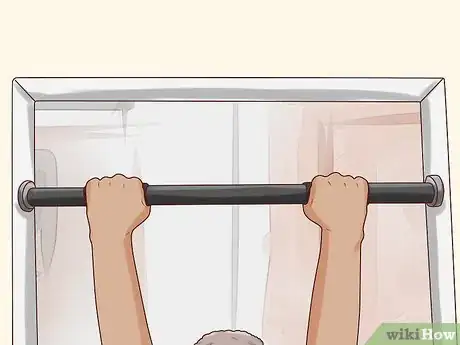
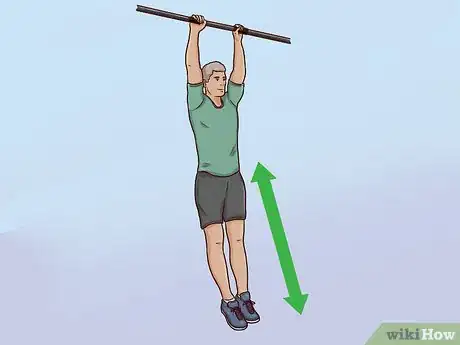
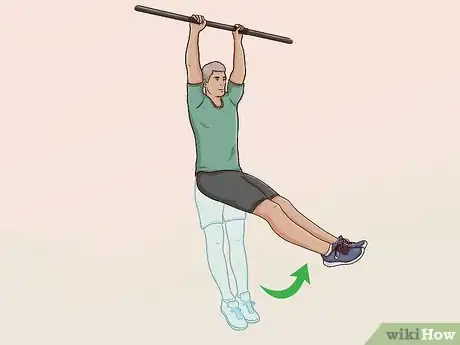
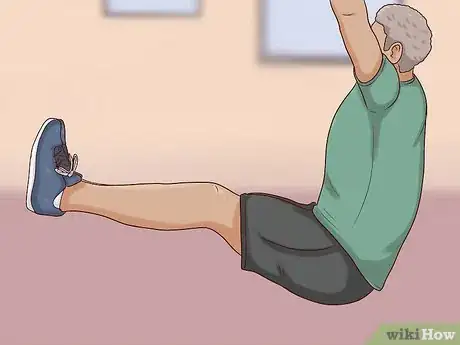
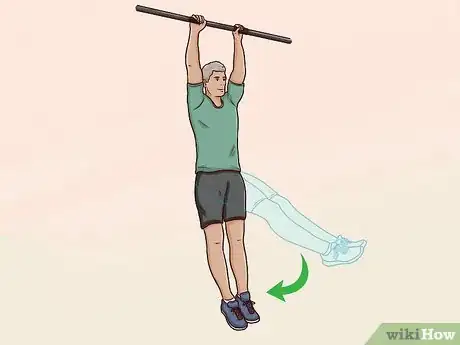
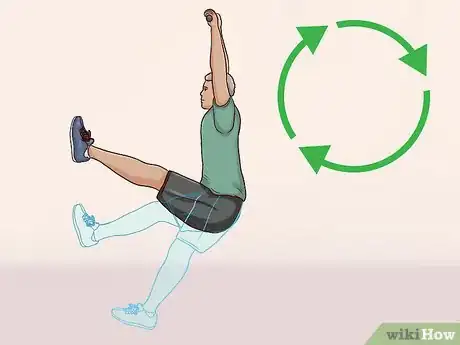
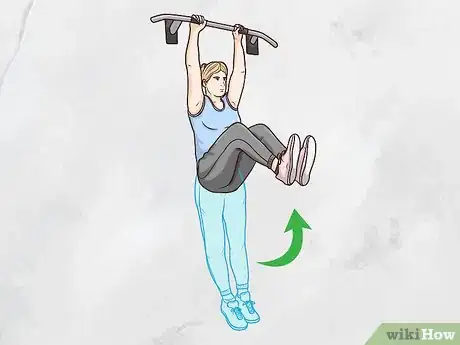


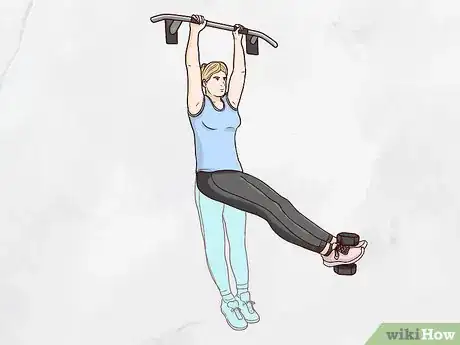
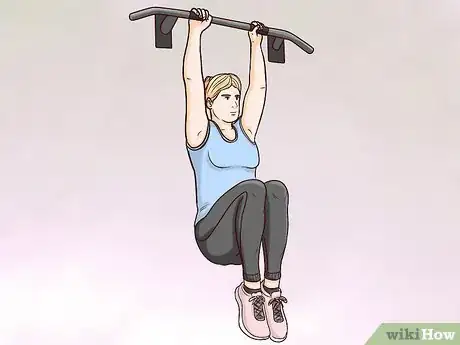
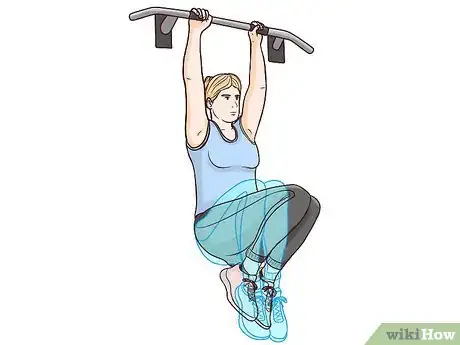






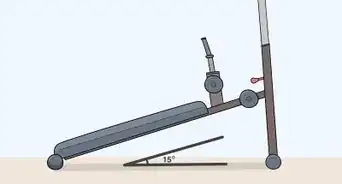
-Step-9-Version-12.webp)













































